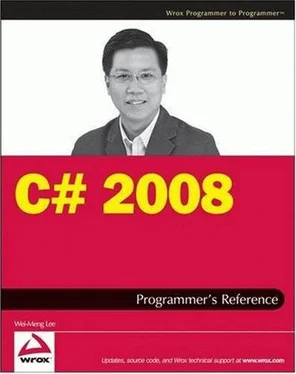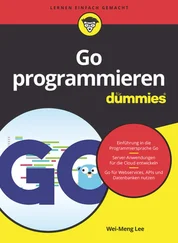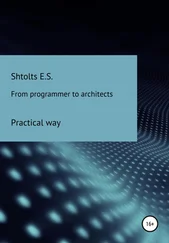Wei-Meng Lee - C# 2008 Programmer's Reference
Здесь есть возможность читать онлайн «Wei-Meng Lee - C# 2008 Programmer's Reference» весь текст электронной книги совершенно бесплатно (целиком полную версию без сокращений). В некоторых случаях можно слушать аудио, скачать через торрент в формате fb2 и присутствует краткое содержание. Город: Indianapolis, Год выпуска: 2009, ISBN: 2009, Издательство: Wiley Publishing, Inc., Жанр: Программирование, на английском языке. Описание произведения, (предисловие) а так же отзывы посетителей доступны на портале библиотеки ЛибКат.
- Название:C# 2008 Programmer's Reference
- Автор:
- Издательство:Wiley Publishing, Inc.
- Жанр:
- Год:2009
- Город:Indianapolis
- ISBN:978-0-470-28581-7
- Рейтинг книги:4 / 5. Голосов: 1
-
Избранное:Добавить в избранное
- Отзывы:
-
Ваша оценка:
- 80
- 1
- 2
- 3
- 4
- 5
C# 2008 Programmer's Reference: краткое содержание, описание и аннотация
Предлагаем к чтению аннотацию, описание, краткое содержание или предисловие (зависит от того, что написал сам автор книги «C# 2008 Programmer's Reference»). Если вы не нашли необходимую информацию о книге — напишите в комментариях, мы постараемся отыскать её.
C# 2008 Programmer's Reference — читать онлайн бесплатно полную книгу (весь текст) целиком
Ниже представлен текст книги, разбитый по страницам. Система сохранения места последней прочитанной страницы, позволяет с удобством читать онлайн бесплатно книгу «C# 2008 Programmer's Reference», без необходимости каждый раз заново искать на чём Вы остановились. Поставьте закладку, и сможете в любой момент перейти на страницу, на которой закончили чтение.
Интервал:
Закладка:
□ Chapter 5 explains how interfaces can be used to define the contract for a class. It also discusses difference between an interface and an abstract class.
□ Chapter 6 looks at how inheritance facilitates code reuse, enabling you to extend the functionality of code that you have already written. This book explains the different types of inheritance and how to define overloaded methods and operators.
□ Chapter 7 introduces the concept of delegates and events used in object oriented programming, and discusses what a delegate is and how delegates are used to implement events.
□ Chapter 8 examines strings handling in C# and the various ways to manipulate them. For more complex strings pattern matching, you can use regular expressions. This chapter also covers the various ways to format your strings data.
□ Chapter 9 looks into the basics of generics and how you can use them to enhance efficiency and type safety in your applications. Generics enable developers to define type-safe data structures without binding to specific fixed data types at design time.
□ Chapter 10 explains how to write multithreaded applications using the Thread class in the .NET Framework. It also shows you how to create and synchronize threads as well as how to write thread-safe Windows applications.
□ Chapter 11 delves into the concepts of files and streams in .NET. With streams, you can perform a wide range of tasks, including compressing and decompressing data, serializing and deserializing data, and encrypting and decrypting data. This chapter covers the various ways to manipulate files and the various stream objects in .NET.
□ Chapter 12 deals with exception handling. An exception is a situation that occurs when your program encounters an error that it is not expecting during runtime. Understanding how to handle exceptions makes your program more robust and resilient.
□ Chapter 13 examines arrays and collections. It discusses the many collection classes that you can use to represent groups of data in .NET.
□ Chapter 14 introduces a new feature in .NET 3.5: Language Integrated Query (LINQ). It covers all the important implementations of LINQ — LINQ to Objects, LINQ to XML, LINQ to Dataset, and LINQ to SQL.
□ Chapter 15 explores the concept of assemblies. In .NET, the basic unit deployable is called an assembly. Assemblies play an important part of the development process where understanding how they work is useful in helping you develop scalable and efficient .NET applications.
□ Chapter 16 demonstrates how you can build a Windows application using the C# language. The sample application illustrates how to perform FTP using the classes available in the .NET Framework. You will also see how to perform printing in a.NET application and how to deploy Windows applications using the ClickOnce technology.
□ Chapter 17 takes you through building an ASP.NET web application in C#. You perform data binding using the new LinqDataSource control and see how to AJAX-enable your web pages.
□ Chapter 18 illustrates Windows Mobile development using the .NET Compact Framework, a subset of the .NET Framework. It examines the basics of the Windows Mobile development and builds a sample RSS reader application. Finally, it shows you how to create a professional setup package for your application so that it can be distributed to your readers for installation.
□ Chapter 19 helps you get started with Silverlight and provides an opportunity for you to get a feel for Silverlight development works. It covers Silverlight 1.0 and 2, and contains several examples showing the capabilities of Silverlight, including animation, media, and .NET integration.
□ Chapter 20 provides a quick introduction to the new Windows Communication Foundation (WCF) technology and shows how it addresses some of the limitations of today's web services technology. While most books and conferences focus heavily on the theory behind WCF, this chapter shows you how to build WCF services and then explains the theory behind them. It ends with an example that creates a ticketing application, allowing multiple clients to obtain updated seat information in real time.
□ Appendix A lists the various keywords in C# that are predefined and have special meanings to the compiler.
□ Appendix B summarizes the features of the various versions of the .NET Framework and explains how to use the Object Browser feature in Visual Studio 2008 to browse the available namespaces and classes in the .NET Framework.
□ Appendix C shows you how to generate MSDN-style documentation for your project using Visual Studio 2008 and a third-party documentation generation tool — Sandcastle.
For all the examples demonstrated in this book, I used Microsoft Visual Studio Team System 2008. However, Microsoft has released a plethora of editions of Visual Studio designed for the different types of C# developers:
□ Visual Web Developer 2008 Express Edition
□ Visual C# 2008 Express Edition
□ Visual Studio 2008 Standard Edition
□ Visual Studio 2008 Professional Edition
□ Visual Studio 2008 Team System 2008 Architecture Edition
□ Visual Studio 2008 Team System 2008 Database Edition
□ Visual Studio 2008 Team System 2008 Development Edition
□ Visual Studio 2008 Team System 2008 Test Edition
□ Visual Studio 2008 Team System 2008 Team Suite
For a detailed discussion of the features available in each edition, check out the following URL: http://msdn.microsoft.com/en-us/vs2008/products/cc149003.aspx.
Express editions are designed for hobbyists and are available for download at no charge. This is a great way to get started with Visual Studio 2008 and is ideal for students and beginning programmers. However, if you are a professional developer, you should purchase either the Standard or Professional Edition. If you are developing Windows Mobile applications, you need the Professional Edition (or higher). If you are working in a large development environment and need to develop collaboratively with other developers on large projects, check out the Team System editions.
If you are not ready to purchase Visual Studio 2008, you can always download a 90-day trial edition of Visual Studio 2008 Professional from http://msdn.microsoft.com/en-us/vs2008/products/cc268305.aspx.
Depending on the edition of Visual Studio you are using, some of the steps illustrated in this book may not appear exactly the same on your screen. However, the differences are minor, and you should not have any problem in following the steps outlines in each chapter.
In addition, readers using Windows Vista should launch Visual Studio 2008 (as well as the Command Prompt window) in Administrator mode. To do so:
□ Click on Vista Start button.
□ Locate the program you want to launch (Visual Studio 2008, or Command Prompt).
□ Right-click on the program and select Run as Administrator.
A number of conventions are used throughout the book to help you get the most from the text and keep track of what's happening.
Boxes like this one hold important, not-to-be forgotten information that is directly relevant to the surrounding text.
Tips, hints, tricks, and asides to the current discussion are offset and placed in italics like this.
As for styles in the text:
□ New terms and important words are highlighted introduced.
□ Keyboard strokes look like this: Ctrl+A.
□ Filenames, URLs, and code within the text looks like this: persistence.properties.
□ Code is presented in two different ways:
Читать дальшеИнтервал:
Закладка:
Похожие книги на «C# 2008 Programmer's Reference»
Представляем Вашему вниманию похожие книги на «C# 2008 Programmer's Reference» списком для выбора. Мы отобрали схожую по названию и смыслу литературу в надежде предоставить читателям больше вариантов отыскать новые, интересные, ещё непрочитанные произведения.
Обсуждение, отзывы о книге «C# 2008 Programmer's Reference» и просто собственные мнения читателей. Оставьте ваши комментарии, напишите, что Вы думаете о произведении, его смысле или главных героях. Укажите что конкретно понравилось, а что нет, и почему Вы так считаете.












